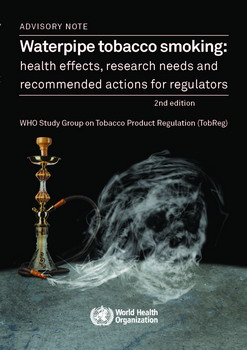 20 July 2017 – Waterpipe tobacco smoking (shisha) is increasing globally, and is especially prevalent in the Eastern Mediterranean Region. Young people are particularly at risk. Smoking rates can reach 42% among boys and 31% among girls in this Region. This includes smoking shisha, which is more popular among young people than cigarettes.
20 July 2017 – Waterpipe tobacco smoking (shisha) is increasing globally, and is especially prevalent in the Eastern Mediterranean Region. Young people are particularly at risk. Smoking rates can reach 42% among boys and 31% among girls in this Region. This includes smoking shisha, which is more popular among young people than cigarettes.
Over the past 10 years, WHO has accumulated evidence on the increasing prevalence of shisha and its effects on health. This evidence is presented in the second edition of the WHO Study Group on Tobacco Product Regulation scientific advisory note on waterpipe tobacco smoking. The note provides a more thorough understanding of the health effects of waterpipe smoking for WHO, countries and research entities.
Health effects of waterpipe smoking
Every study to date has found that waterpipe tobacco smoke contains ample quantities of the toxicants known to cause diseases in cigarette smokers, including cancer, and that at least some of those toxicants are effectively absorbed by waterpipe users and are therefore present in their breath, blood and urine. The evidence shows that waterpipe tobacco smoking is probably associated with oral, oesophageal and lung cancers and possibly with gastric and bladder cancers. There is also evidence of associations with respiratory disease, cardiovascular disease, periodontal disease, low birth weight, perennial rhinitis, male infertility, gastro-oesophageal reflux disease and impairment of mental health.
Suggested actions for regulators
In light of the widespread, growing use of waterpipes worldwide, strong control measures are needed to limit the spread of this practice to protect public health. Here are some suggested actions for regulators.
Implement tax measures on tobacco products and restrict or prohibit importation and sale of duty-free tobacco and waterpipe products.
Indoor waterpipe smoking in public areas should be prohibited and waterpipe venues should not be allowed within large shopping areas, such as indoor malls.
Waterpipe tobacco and waterpipe smoke should be tested by the same stringent standards that are applied to cigarette tobacco.
Prohibit manufacturers and third parties from making health and safety claims for waterpipe tobacco smoking and accessories.
Waterpipe tobacco packaging should not be allowed to carry health or safety claims.
Health warnings should indicate the various harmful effects of tobacco use and must be placed on waterpipe tobacco packaging and also on all accessories and on waterpipes themselves.
Comprehensive education and public awareness programmes on the dangers of waterpipe smoking should be implemented, and should specifically address the fallacy that waterpipe smoking is safer or healthier than smoking cigarettes.
Any form of waterpipe advertising, promotion and sponsorship must be regulated by an appropriate government body, which can be done most easily by making certain that waterpipes are included in all legislation and regulations governing cigarette advertising, promotion and sponsorship, without exception.
Cessation programmes for tobacco dependence should include waterpipe tobacco smoking dependence, and the interventions should target the unique features that make waterpipe smoking appealing and thus difficult to quit.








